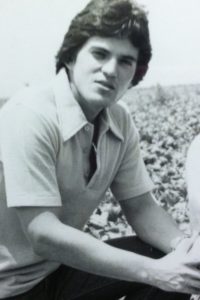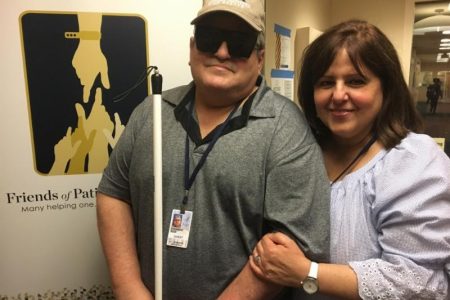Eduardo, 59, a successful vegetable producer lost his business and home in Texas due to a rare eye disorder that causes the muscles around his eyes to spasm and his eyes to close involuntarily. The disorder has left him functionally blind.
The unusual disease, blepharospasm, initially attacked him without warning when he was driving with his mother. His eyes suddenly closed, and he could only open them with his hands. He slammed on the brakes and was safe, but it was alarming.
The only warning sign in 2007, Eddie would later realize, was that he had been blinking his eyes frequently. (One of the earliest signs of the disorder can be dry eyes.) It took several years of dead-end treatments and progressively dire symptoms including severe sensitivity to light, and excruciating headaches for Eddie to learn what was wrong. Sylvia, his wife googled his symptoms and found the Blepharospasm Foundation in Texas which directed them to the NIH.
There is no cure for blepharospasm, so far, but at the NIH, Eddie, and his medical team are focusing on relieving symptoms through injections of botulinum toxin, Botox. The Botox relaxes the muscles around the eyes, and for a period of time, provides some relief to the debilitating symptoms.

Eddie R, Young Texas Businessman
Dr. Mark Hallet in the National Institute of Neurological Disorders and Stroke (NINDS) who heads Eddie’s medical team, has pioneered the use of botulinum toxin (Botox), since 1985, to block the release of the neurotransmitter acetylcholine, which normally causes muscles spasms.
In Eddie’s course of treatment, originally the botulinum toxin was injected in clinics in Texas, but the cost rose from $60 an injection to over $1000 with doctors’ fees.
Eddie couldn’t afford the steep deductible on his insurance. The financial cost of the disease was devastating to him. “I was never lazy. I worked 7 days a week, 12 hours a day,” he explained, “I had to drive around, check all the produce. Hold it, look at it. I had to know how it tasted. I’d been doing it since I was 15 years old.” When he could no longer do that, he lost everything.
Eddie enrolled in rehabilitation classes for the newly-blind, but as he had once been active and social, he soon isolated himself due to his eyes’ light sensitivity. Anxiety and depression nearly overwhelmed him. That’s when he learned about the NIH research study.
Friends of Patients at the NIH has made the trips to the NIH possible by supporting Eddie’s and Sylvia’s airfares. His treatment is covered by the National Institute of Neurological Disorders and Stroke (NINDS). Eddie choked up as he explained how grateful he is to donors who make his travel to his NIH treatment possible. “Yes, NIH and Friends at NIH are heaven sent,” added Sylvia.
In spite of his losses, Eddie is positive about his future and proud to be a part of an NIH study. “It means so much more than just the injections to work with the NIH. I feel like I am making a positive contribution to working toward a cure for blepharospasm.”
What is Blepharospasm?
Benign essential blepharospasm (BEB) is a progressive neurological disorder characterized by involuntary muscle contractions and spasms of the eyelid muscles. It is a form of dystonia, a movement disorder in which muscle contractions cause sustained eyelid closure, twitching or repetitive movements. Generally, the spasms occur during the day, disappear in sleep, and reappear after waking. As the condition progresses, the spasms may intensify, forcing the eyelids to remain closed for long periods of time, and thereby causing substantial visual disturbance or functional blindness. It is important to note that the blindness is caused solely by the uncontrollable closing of the eyelids and not by a dysfunction of the eyes. – NINDS, National Institute of Neurological Disorders and Stroke website.





